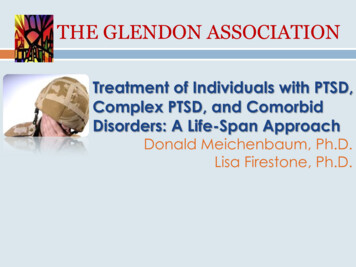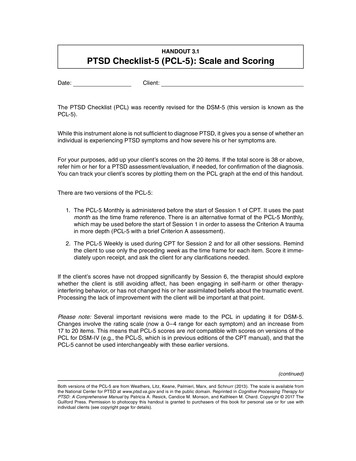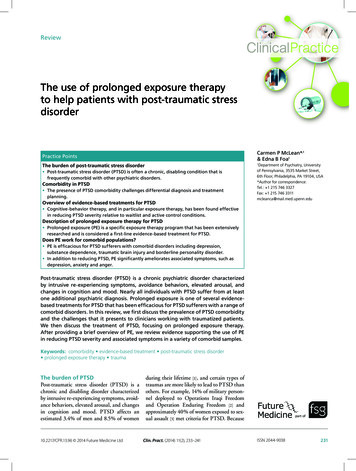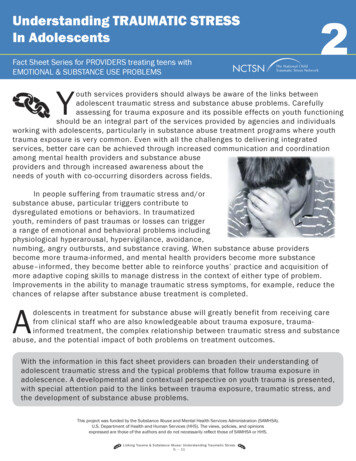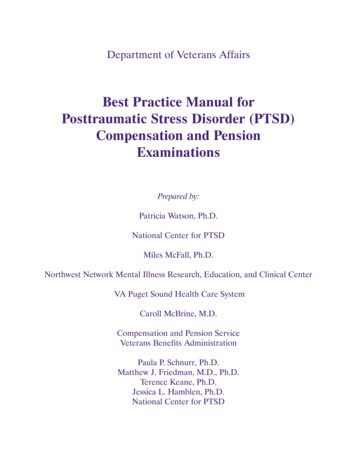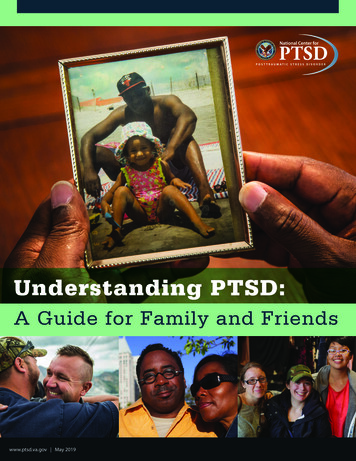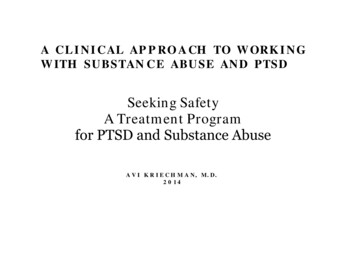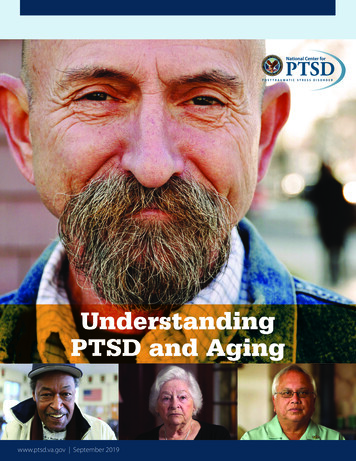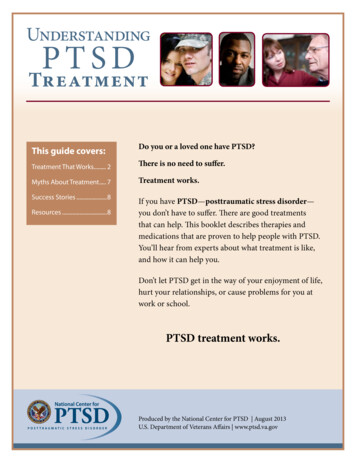
Transcription
UnderstandingPTSDTreatmentThis guide covers:Do you or a loved one have PTSD?Treatment That Works. 2There is no need to suffer.Myths About Treatment. 7Treatment works.Success Stories.8Resources.8If you have PTSD—posttraumatic stress disorder—you don’t have to suffer. There are good treatmentsthat can help. This booklet describes therapies andmedications that are proven to help people with PTSD.You’ll hear from experts about what treatment is like,and how it can help you.Don’t let PTSD get in the way of your enjoyment of life,hurt your relationships, or cause problems for you atwork or school.PTSD treatment works.Produced by the National Center for PTSD August 2013U.S. Department of Veterans Affairs www.ptsd.va.gov
T reatment That WorksWhat is PTSD?Posttraumatic stress disorder, or PTSD, can occur aftersomeone goes through or sees a traumatic event like: Combat exposure Child sexual or physical abuse Terrorist attack Sexual/physical assault Serious accident Natural disasterMost people have some stress-related reactions after atraumatic event. Fear, sadness, guilt, anger, and sleepproblems are common. You may have bad memories ofthe event. If your reactions don’t go away over time andthey disrupt your life, you may have PTSD.Available TreatmentsThere are good treatments available for PTSD. Thetwo main types are psychotherapy, sometimes called“counseling,” and medication. Sometimes peoplecombine psychotherapy and medication. The followingtreatments for PTSD work: Cognitive Behavioral Therapy (CBT), such as Cognitive Processing Therapy (CPT)Symptoms of PTSDPTSD has four types of symptoms: Reliving the event (also called reexperiencing):Memories of the trauma can come back at any time.You may have nightmares or feel like you are goingthrough it again. This is called a flashback. Avoiding situations that remind you of the event:You may try to avoid situations or people that bringback memories of the event. Negative changes in beliefs and feelings: The wayyou think about yourself and others changes becauseof the trauma. You may have trouble experiencingyour emotions, think no one can be trusted, or feelguilt or shame. Feeling keyed up (also called hyperarousal): Youmay be jittery and on the lookout for danger. Youmight suddenly become angry or irritable. This isknown as hyperarousal.www.ptsd.va.gov Prolonged Exposure Therapy (PE) Eye Movement Desensitization and Reprocessing(EMDR) Medications called Selective Serotonin ReuptakeInhibitors (SSRIs)Getting BetterCBT, EMDR, and SSRIs have the best evidence fortreating PTSD. Researchers around the world haveexamined them. They have found better outcomes forpeople who get these treatments than for people whoreceive other treatments, or no treatment at all.All three treatments can cause positive and meaningfulchanges in symptoms and quality of life for the peoplewho use them. “Getting better” means different thingsfor different people, and not everyone who gets one ofthese treatments will be “cured.” But they will likely dobetter than people with PTSD who were not treated, orwho received other kinds of treatment.2
Psychotherapy (Counseling)Cognitive behavioral therapy (CBT) is the mosteffective treatment for PTSD. CBT usually involvesmeeting with your therapist once a week for up tofour months. There are different types of cognitivebehavioral therapy. The two most-researched typesof CBT for PTSD are Cognitive Processing Therapy(CPT) and Prolonged Exposure (PE).What is Cognitive Processing Therapy?Cognitive Processing Therapy (CPT)Why it works:Trauma often causes people to struggle with memoriesand thoughts of the event. You may get “stuck” on thesethoughts and feel unable to make sense of the trauma.CPT can give you skills to handle these distressingthoughts. It helps you understand what you went throughand how the trauma changed the way you look at theworld, yourself, and others. In CPT, you will focus onexamining and challenging thoughts about the trauma. Bychanging your thoughts, you can change the way you feel.CPT has four main parts: Learning about your PTSD symptoms and howtreatment can help Becoming aware of your thoughts and feelings Learning skills to challenge your thoughts andfeelings (cognitive restructuring) Understanding the common changes in beliefs thatoccur after going through traumaIn addition to regular meetings with your therapist, youwill get practice assignments to help you use your newskills outside of therapy.Tara Galovski, PhDPsychologist and Assistant ProfessorUniversity of Missouri, St. Louis“In CPT, we examine what you’re thinking andtelling yourself about your trauma and decidewhether those thoughts are accurate or inaccurate.For example, frequently people heap blame onthemselves for these awful things that happened,saying things like, ‘It’s my fault that my buddy died,’or ‘I shouldn’t have worn a short dress; that’s why Iwas raped.’These inaccurate thoughts cause a lot of distress.So together we challenge those thoughts to seeif we can come up with a conclusion that’s moreaccurate, more balanced.In CPT, we’re not changing the details of whathappened, we’re changing the things that you’retelling yourself that are increasing your PTSDsymptoms. If you start telling your mind moreaccurate things, then all of a sudden the tunnelstarts to open up a little bit. And once you’vestarted thinking in this way, you don’t stop. Yourmind opens up to different possibilities. The relief isjust inevitable. It’s not a magic bullet. It’s just logic.It never ceases to amaze me how people canchange remarkably in a very brief time. Whenpeople come back for a three-month or a sixmonth follow-up visit, many times I have walkedout into the waiting room and not even recognizedthe person! Hats are off, nail polish is on, weightlost, hair done up It’s pretty remarkable.”www.ptsd.va.gov3
Prolonged Exposure Therapy (PE)Why it works:Repeated exposure to thoughts, feelings, and situationsthat you have been avoiding helps you learn thatreminders of the trauma do not have to be avoided. InPE, you and your therapist will identify the situations youhave been avoiding. You will repeatedly confront thosesituations until your distress decreases.PE has four parts: Education: to learn about your symptoms and howtreatment can help Breathing retraining: to help you relax and managedistress Real world practice (in vivo exposure): to reduce yourdistress in safe situations you have been avoiding Talking through the trauma (imaginal exposure):to get control of your thoughts and feelings aboutthe traumaPE usually involves 8–15 sessions with a therapist, pluspractice assignments you will do on your own. Withtime and practice, you learn to manage your reactionsto stressful memories.Why is exposure important?Kevin Beasley, LCSWSocial WorkerDepartment of Veterans Affairswww.ptsd.va.govWhat is Prolonged Exposure?Matthew Yoder, PhDPsychologistDepartment of Veterans Affairs“PE is a treatment that helps people face their fears.Think of a wound on the battle field; a person’s outthere fighting and they get a deep cut in their arm.They wrap it up with the bandage in their hip pocketand keep fighting. After the battle, they go backto the base and they have this wound. It’s a deepgaping wound with a field bandage on it. There’s a lotof dirt in there that can get infected.The person has to decide what they want to do: dothey want to take the bandage off and clean it out, ordo they want to leave the bandage on and take theirchances that it’ll heal on its own?Most of the time, they need to take the bandage off andclean out the wound, and that’s what exposure therapyis. It’s facing something that can be a little painful andhurtful at the beginning, but it’s a treatment that helpsthe person do that at their own pace.”“One of the things that I tell patients is that treatment is going toinvolve not only talking about your trauma in a lot of detail, but tapingthat and listening to those tapes daily. And we’re also going to dowhat we call in vivo exposure.What that means is going out into the environment to practice andrelearn that under a different set of circumstances that bus stop whereyou were raped is just a bus stop. That trash on the side of the road---ifyou’re a Veteran and you had an IED blow up---well, in a different setof circumstances, that trash is just trash. We’re having you experiencesome of those things in this environment so that you can make theconnection that there has been a change. And then your body actuallystarts to change its reaction. You won’t get as anxious.“4
What is EMDR?Eye Movement Desensitization andReprocessing (EMDR)Why it works:In EMDR, you focus on hand movements or tappingwhile you talk about the traumatic event. The idea is thatthe rapid eye movements make it easier for our brains towork through the traumatic memories. Focusing on handmovements or sounds while you talk about the traumaticevent may help change how you react to memories ofyour trauma over time. You also learn skills to help yourelax and handle emotional distress.Susan Rogers, PhDPsychologistDepartment of Veterans Affairs“When a client comes in for EMDR, I ask them toidentify the most disturbing part of the traumamemory. Usually there is one image that is themost disturbing. I ask them what negative beliefabout themselves goes with that picture, whatemotion they’re feeling, what sensations theyEMDR has four main parts: Identification of a target memory, image, and beliefabout the trauma Desensitization and reprocessing: focusing on mentalimages while doing eye movements that the therapisthas taught you Installing positive thoughts and images, once thenegative images are no longer distressing Body scan: focusing on tension or unusual sensationsin the body, to identify additional issues you mayneed to address in later sessionsfeel in their body, and then have them focus onthat while we do brief sets of eye movements. Iusually just have them follow my hand back andforth with their eyes.Over time, EMDR can change how your react tomemories of your trauma. A course of four to twelvesessions is common.The idea behind EMDR is that PTSD symptomsare really a matter of incompletely processedexperience. Your brain is designed to takeeveryday experiences, sort them out, store theuseful parts, and get rid of the part you don’t need.When a trauma happens, some people get kind ofhung up and don’t complete the processing. Theyneed some assistance from therapy and that’s ourgoal: to help somebody sort the memory out.The eye movements help people relax enoughto think clearly about the trauma, sort it all out,and resolve it.”www.ptsd.va.gov5
MedicationSelective Serotonin Reuptake Inibitors(SSRIs)Will I be on medication forever?Why they work: SSRIs can raise the level of serotonin inyour brain, which can make you feel better. The two SSRIsthat are currently approved by the FDA for the treatmentof PTSD are sertraline (Zoloft) and paroxetine (Paxil).Possible side effects that may occur in fewer than one outof three people who take SSRIs include: Nausea (feeling sick to your stomach)Matthew J. Friedman, MD, PhDPsychiatrist, VA National Center for PTSDProfessor, Dartmouth Medical School Decreased interest in sex“If a person has had a good response to Feeling drowsy, tired, or sleeping too muchmedication, the likelihood is that he or she is goingPTSD medications may interact with other medicationsyou are taking. You should check with your doctor aboutall medications you are taking.to need to be on that medication indefinitely. Nowwhat I do with my patients is, if they’ve had a goodyear of symptom-free living, then we’ll test thewaters. I’ll reduce the dose gradually, and if we canget away with it, I’m more than happy to stop theQuestions to Ask a Potential Therapistmedication. But more often than not, people needto stay on their medication indefinitely.q What is your education? Are you licensed?How many years have you been practicing?That’s the big difference between therapy andq What are your special areas of practice?medication; with medication you need to beq Have you ever worked with people who have beenthrough trauma? Do you have any special training inPTSD treatment?q What kinds of PTSD treatments do you use? Havethey been proven effective for dealing with my kind ofproblem or issue?q What are your fees? (Fees are usually based on a45–50 minute session.) Do you have any discountedfees? How much therapy would you recommend?on it indefinitely for the most part, whereasfor psychotherapy, you typically need 10–12sessions and maybe a ‘booster’ now and then.You don’t need much more. So for a patient thatdoesn’t want to be on medication indefinitely,that can be another motivation for them to gointo psychotherapy.”Warning: Sometimes, doctors prescribe medicinesq What types of insurance do you accept? Do youfile insurance claims? Do you contract with anymanaged care organizations? Do you acceptMedicare or Medicaid?called “benzodiazepines” for people with PTSD. TheseYour therapist should explain the therapy, howlong treatment is expected to last, and how totell if it is working.may lead to addiction, especially for people who havewww.ptsd.va.govmedicines are often given to people who have problemswith anxiety. While they may be of some help at first,they do not treat the core PTSD symptoms. They alsohad problems with alcohol or drugs. So, benzodiazepinesare not recommended for long-term PTSD treatment.6
M yths About TreatmentMyth: Therapists just nod their heads and listen.Fact: CPT, PE, and EMDR are active treatments wherethe patient and therapist work together. Therapistsare very engaged. Sessions are goal-oriented.Elements of treatment are skills-based.Myth: My trauma happened a longtime ago, so treatment won’t work.Myth: Therapy goes on for years and years.Fact: CPT, PE, and EMDR are all time-limited treatmentsMyth: Therapists “get inside your head” to change whoyou are.Fact: Therapists help you understand your thoughts andfeelings so that you have more control over them.Myth: I can get better on my own.Fact: If you have had PTSD for a year or more, thechance of getting better without counseling ormedication is quite small.Myth: If I have to talk about trauma, I’ll “lose it.”Fact: Therapy takes place in a safe, controlledenvironment, and you work with the therapist to goonly as far as you feel safe. You learn coping skills tohelp you manage your anxiety.Myth: Only a therapist who’s been through what I’ve beenthrough understands this well enough to help me.Fact: Providers with and without their own traumahistories can effectively deliver PTSD treatments.What’s important is that the provider has goodtraining and experience, and can help youdevelop the skills you need to get better.Myth: All I need to get better is the support of other peoplewho’ve been through what I’ve been through.Fact: Support groups can provide social support andinterpersonal connection, but there’s little evidencethat they help the PTSD symptoms themselves.Candice Monson, PhDPsychologist and Associate ProfessorRyerson University“No matter how long it’s been,there’s good reason to think thatyou can get better.”“One thing that I’ve heard from older Veterans thatI’ve treated is, ‘I can’t believe how much time I’vewasted; that I’ve been living with these symptomsfor 35 years. Why didn’t I do this before?’Thirty years ago, we didn’t know how to treatPTSD. Just like other areas of medicine, we’vecome a long way. So ask yourself, do you wantto spend the rest of your years living with yoursymptoms? What might your life look like if youwere free of them? Even if you’re an older personwho’s had your symptoms for a long time, thetherapy still works, and there’s hope for you tohave a different life.The most important thing is just to address it. Nomatter how long it’s been, there’s good reason tothink that you can get better.”www.ptsd.va.gov7
S uccess StoriesMaria used to enjoy socializing, but aftershe was mugged, she couldn’t even goon simple outings with her family. Drivingwas difficult. Going to a movie theater wasimpossible. When she did manage to go outto dinner, she was so focused on what wasgoing on around her that she couldn’t enjoyher meal or join the conversation.After treatment, things changed. Now,she can sit down with her family andenjoy a meal at a restaurant. She can evenspend a day at an amusementpark, where there are crowdseverywhere, and not be anxious.“I still have some things that bugme,” she says, “but my life hasimproved so much that the thingsthat bother me are just small.”George is a Vietnam Veteranwho’d been a medic. AVietnamese mother brought herbadly injured child to his fieldhospital. He was unable to savethe child, who died in his arms.Back home, he never held hisown children. “I never heldmy kids, never changed their diapers. Ididn’t want to have that reminder.” Butwith the birth of his first grandchild hedecided to get help. His therapy was asuccess. At the end of his treatment heshowed his therapist a picture of himselfwith his grandson in his arms. He said, “Ilove holding my grandson. And you knowwhat? I couldn’t hold my kids then, but I’mholding them now.”R esourcesTreatment ResourcesMore About PTSD TreatmentThese links are accessible online atwww.ptsd.va.gov/public/where-to-get-help.aspView the multimedia companion to this booklet andother resources at www.ptsd.va.gov/public/ Finding a Therapist Help for Veterans with PTSD Mental Health Services Locator Veterans Affairs PTSD Program Locator Where to Get Help for PTSDThis guide was created by the National Center for PTSD, U.S. Department of Veterans Affairs. The Center conducts researchand education on trauma and PTSD. Our website offers extensive information, educational materials, and multimediapresentations for a variety of audiences, including Veterans and their families, providers, and researchers.Website: www.ptsd.va.govwww.ptsd.va.gov8
PTSD — posttraumatic stress disorder — you don't have to suffer. There are good treatments that can help. This booklet describes therapies and medications that are proven to help people with PTSD. You'll hear from experts about what treatment is like, and how it can help you. Don't let PTSD get in the way of your enjoyment of life,
